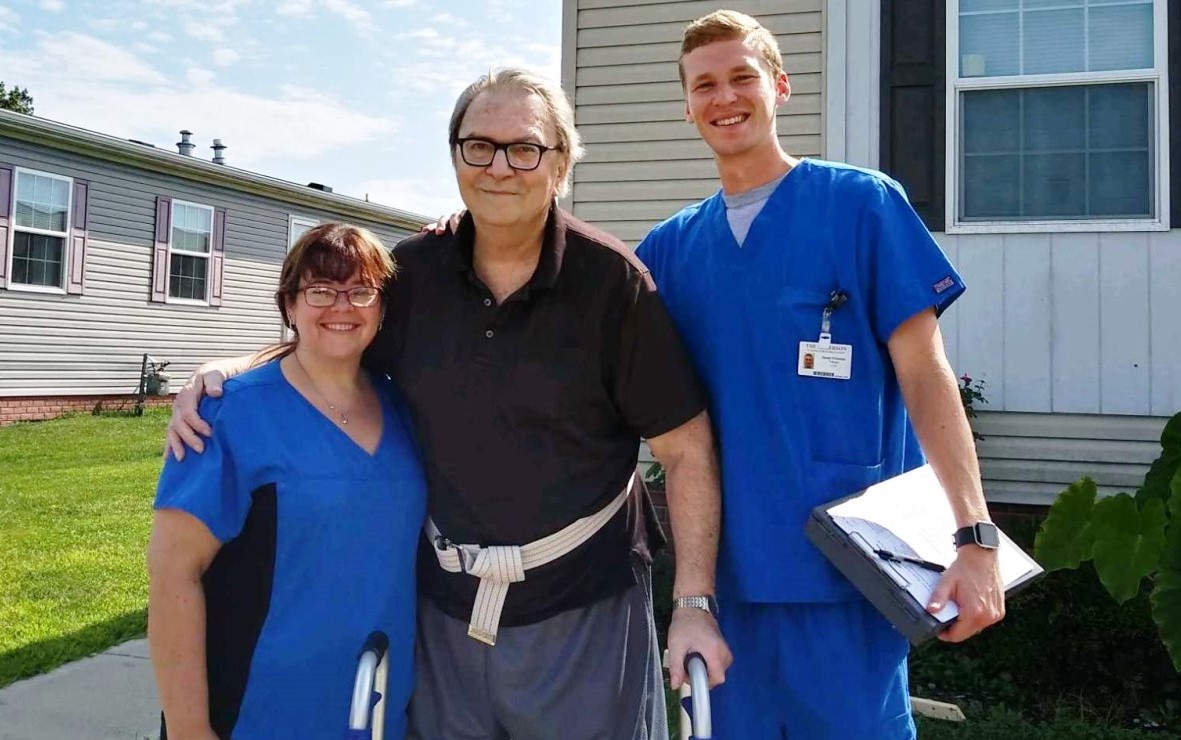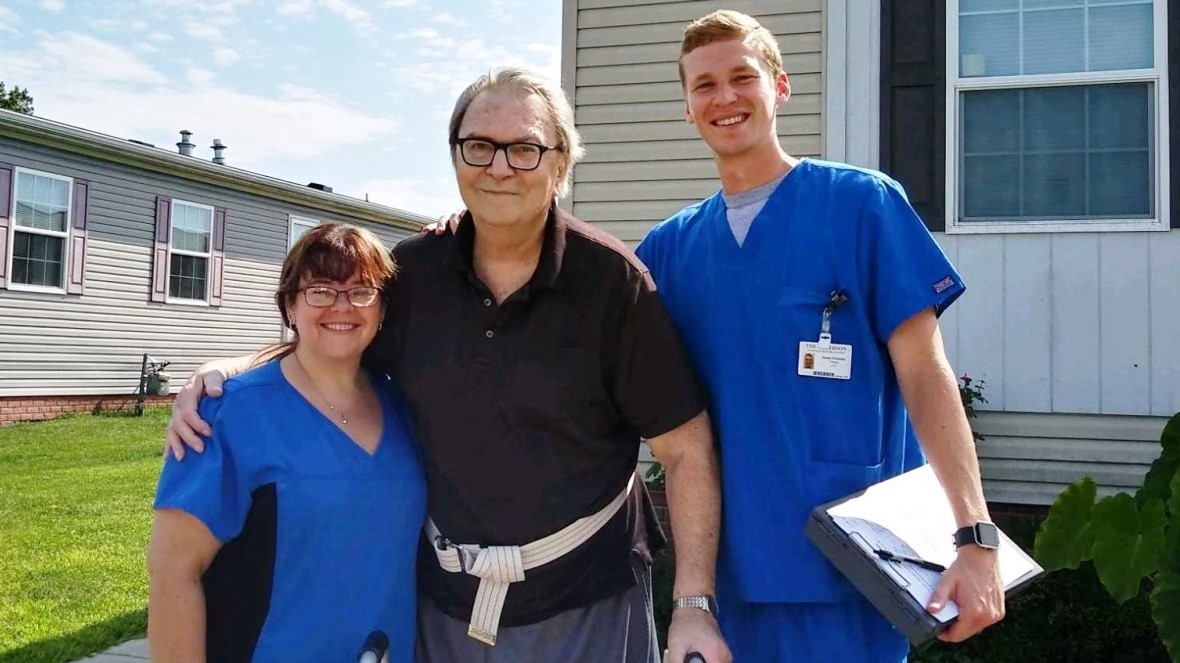As we get older, our bones get more brittle, making a fall risky. Conditions like Osteoporosis, are one of the many causes of falls or a hip fracture in the elderly population.
Many people have come to The Anderson for a short term rehabilitative stay, with a fractured bone or back injury, due to a fall. Below is some information, to help you become more educated in the process, of a successful recovery & rehabilitation.
Timeframe to Recover From a Hip Fracture
Families ask me all the time, “How long will mom be there?” I hate to say I don’t know, but everyone recovers at a different pace.
We have to consider mood, previous abilities, strength and supports. I like to tell our clients we are not the ones that get you better, we only provide the tools and cheerleading, you decide what works for you and how to apply it to meet your goals.
On average our clients are back in their homes in 20 days or less.
When Will I Be Able to Walk Again?

Learning to walk again after a hip fracture, is not a simple task. If we could only remember the year or two it took to learn the first time, a week or two of rehab wouldn’t sound so bad.
As therapist, we use many methods to get you on your feet again including walkers, canes and exercise. The goal generally is to get rid of them one at a time as you get stronger.
With the current insurance limitations, some may leave our facility with a walker or cane and continue strengthening with home therapy.
Complications During Recovery & Rehabilitation
Life is full of “speed bumps” and generally that’s why you look for our help. If recovery was simple, we’d all go home and lay in bed like grandma and Grandpa Jo in Willy Wonka.
Therapists watch for “complexities” that may slow your progress and find ways to adjust our treatment plan. Things like Arthritis, numbness and tingling, breathing troubles, getting tired easily and your general ability to participate, all limit how quickly you can get better.
Sometimes we have to address those before we can even look at the reason you visited our rehab facility.
How Much Therapy is Needed?
The amount of therapy you need is really up to your body’s tolerance level.
Our therapists will give you everything possible, then scale back as needed. We believe you know your body best, and you are the best person to help us determine the approach and intensity that fits your needs. Though we are smart in recognizing some people need a bit more cheerleading to succeed.
What are the Therapy Treatments Like?
The Therapy Department at The Anderson uses a variety of tools to help you feel better.
Strength training is only a small part of your recovery because, for real, no one likes to go to the gym. Instead, we use more functional activities like walking to the bathroom, getting dressed and taking a shower.
Have you ever felt sick and tried to take a shower? That’s exhausting! You use more muscle groups with that one activity than you realize and you feel more relaxed after.
We can look at safety awareness, how strong your heart and lungs are, balance, coordination and problem solving all in one motivating activity. Sometimes the key to success if giving someone a safe environment to learn how to trust their body again.
Is Physical Therapy Painful?
Sessions in therapy can be painful, but remember, pain is your body’s response to a threat. Think of it this way, a bus is going to run you down so you run for your life.
You step in a pot hole and twist your ankle and keep running because that bus is on your tail. You don’t feel the ankle pain until after the bus passes and you’re safe.
Why? The pain in your ankle didn’t change, only the threat did. That’s why some people feel pain more than others (man cold vs woman and such ha!) That’s also why some people notice “new” pain after one resolves.
“My back is great, but my knee is killing me today.”
Education is key. Sometimes just knowing what happened puts perspective on your recovery. How and where your injury occurred. What doctors did to fix it. What to expect in your therapy sessions, etc. You may not have as much pain when you know what happened, why and what to expect.
Sometimes we start with simpler exercises so you have more control over the movements that may hurt. Then gradually introduce the therapist’s help. Confidence is key to tolerating more aggressive strategies with less pain.
Yes, we’re known as the “torturists” and sometimes we take pride in knowing we’ve pushed you past your expectations. In the end, we do it to make you successful.
Plan of Treatment for a Hip Fracture
The plan will depend on many things.
- First how well did you moved before the injury?
- Where was the break?
- What restrictions did your surgeon recommend?
- How can we effectively manage your pain?
All of these need to be taken into consideration when making your plan.
I often start my assessment by asking; “What is your normal day like? You wake up and what happens from there.”
That will give me a good indication of your energy level before the injury. It tells me what is important to you and what functional activities we can focus on to help you get better faster. There is no point in teaching someone to stand in the shower when they prefer to bathe.
Often patients will tell me “what I want to hear” but really, I want to hear the truth. I can teach you 12 ways to do the same task, but it does not good if the task is meaningless to you. For example, teaching someone to put on socks when they prefer to wear sandals!
In the end, your therapy experience is your own. Its’ as unique as you are. We are excited to get to know you and reach your goals whatever they may be!
Nicole Martin OTR/L is a Licensed and Registered Occupational Therapist, and Director of the Therapy Department, at The Anderson Nursing & Rehabilitation Facility. Her passion and desire to help people recover from injuries started at a young age, and she now has 20 years of experience. Nicole has worked with clients ages 6 months to 106 years, in acute care facilities, inpatient rehab, home health care and short term skilled facilities.

